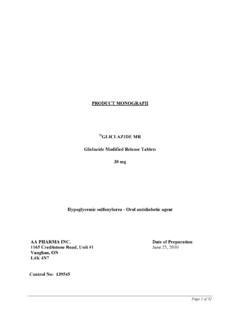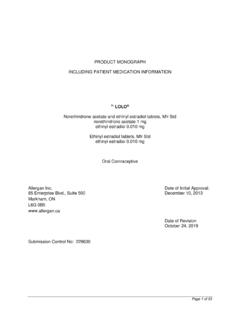Transcription of PrXEOMIN - merzcanada.com
1 XEOMIN - product Monograph Page 1 of 38 product MONOGRAPH PrXEOMIN incobotulinumtoxinA Clostridium Botulinum Neurotoxin Type A (150 kD), free from complexing proteins Powder for solution for injection 50 and 100 LD50 units per vial Pharmaceutical Standard: House Muscle relaxant, peripherally acting agent Manufactured by: Merz Pharmaceuticals GmbH Eckenheimer Landstra e 100 60318 Frankfurt/Main Germany Imported and distributed by: Merz Pharma Canada Ltd.
2 7 Innovation Drive, Unit 115 Flamborough, ON, L9H 7H9 Date of Revision: June 19, 2013 Control No: 165909 Date of Approval: June 28, 2013 XEOMIN - product Monograph Page 2 of 38 Table of Contents PART I: HEALTH PROFESSIONAL INFORMATION .. 3 SUMMARY product 3 DESCRIPTION .. 3 INDICATIONS AND CLINICAL USE .. 3 CONTRAINDICATIONS .. 4 WARNINGS AND PRECAUTIONS .. 5 ADVERSE REACTIONS .. 8 DRUG INTERACTIONS .. 11 DOSAGE AND ADMINISTRATION .. 12 OVERDOSAGE .. 17 ACTION AND CLINICAL PHARMACOLOGY .. 17 STORAGE AND STABILITY .. 19 SPECIAL HANDLING INSTRUCTIONS .. 19 DOSAGE FORMS, COMPOSITION AND 19 PART II: SCIENTIFIC INFORMATION .. 21 PHARMACEUTICAL INFORMATION .. 21 CLINICAL TRIALS .. 23 DETAILED PHARMACOLOGY.
3 28 TOXICOLOGY .. 31 REFERENCES .. 35 PART III: CONSUMER INFORMATION .. 36 XEOMIN - product Monograph Page 3 of 38 PrXEOMIN incobotulinumtoxinA Clostridium Botulinum Neurotoxin Type A (150 kD), free from complexing proteins PART I: HEALTH PROFESSIONAL INFORMATION SUMMARY product INFORMATION Route of Administration Dosage Form / Strength Clinically Relevant Nonmedicinal Ingredients Intramuscular injection Powder for solution for injection 50 and 100 LD50 units per vial None For a complete listing see Dosage Forms, Composition and Packaging section. DESCRIPTION XEOMIN (incobotulinumtoxinA) is produced by the anaerobic bacterial fermentation process from the Hall strain of Clostridium botulinum.
4 It consists of the purified neurotoxin which has been separated from complexing proteins (hemagglutinins and a non-toxic non-hemagglutinating protein) during production. It is a polypeptide comprised of a heavy chain, with a molecular weight of approximately 100 kD, and a light chain, with a molecular weight of approximately 50 kD. These separated chains are covalently linked via a disulphide bond. The light chain is associated with a zinc ion and functions as a zinc-dependent endopeptidase. The heavy chain comprises two functional domains: the N-terminal section is the translocation domain and the C-terminal section is the binding domain. XEOMIN is supplied as a sterile, white, preservative free powder for solution for injection (lyophilisate) packed under nitrogen in glass vials.
5 The vials are closed with rubber stoppers and aluminum caps. Each vial contains either 50 or 100 mouse LD50 units of incobotulinumtoxinA (Clostridium Botulinum Neurotoxin Type A (150 kD), free from complexing proteins), mg of sucrose and mg of human serum albumin. Prior to use XEOMIN is reconstituted with commercially available % physiological saline (not supplied in the pack) to form a clear, and colorless solution. The size of the vials allows different concentrations ( doses) to be prepared. INDICATIONS AND CLINICAL USE XEOMIN - product Monograph Page 4 of 38 XEOMIN is indicated: for the treatment of hypertonicity disorders of the 7th nerve such as blepharospasm including benign essential blepharospasm and hemifacial spasm in adults.
6 To reduce the subjective symptoms and objective signs of cervical dystonia (spasmodic torticollis) in adults for the treatment of upper limb spasticity associated with stroke in adults. XEOMIN as a treatment for focal spasticity has been studied in association with usual standard care regimens and is not intended as a replacement for these treatment modalities. XEOMIN is not likely to be effective at a joint affected by a fixed contracture. XEOMIN may only be used by physicians with suitable qualifications and experience in the application of Botulinum toxin type A. Geriatrics (> 65 years of age): Although clinical studies included a number of patients over the age of 65, no clinical trials specifically designed for elderly patients have been performed.
7 Initial dosing should begin at the lowest recommended dose for the specific indication and be cautiously titrated within the recommended range for optimal patient outcome. Pediatrics (< 18 years of age): XEOMIN has not been studied in the paediatric population and is therefore currently not recommended in this age group. CONTRAINDICATIONS Hypersensitivity to Botulinum neurotoxin type A or to any of the excipients. Generalised disorders of muscle activity ( myasthenia gravis, Lambert-Eaton syndrome). Presence of infection at the proposed injection site. XEOMIN - product Monograph Page 5 of 38 WARNINGS AND PRECAUTIONS Serious Warnings and Precautions The term "unit" or "U" upon which dosing is based, is a specific measurement of toxin activity that is unique to XEOMIN.
8 Therefore, the "unit" or U" used to describe XEOMIN activity are different from those used to describe that of other botulinum toxin preparations and the units representing XEOMIN activity are not interchangeable with other products. Follow the recommended dosage and frequency of administration for XEOMIN (See DOSAGE AND ADMINISTRATION). General In very rare cases severe adverse events like muscle weakness, dysphagia or aspiration pneumonia with a suspected causal relationship to toxin spread have been reported with the use of botulinum toxin. Also very rare cases of adverse events with a fatal outcome have been reported. Patients with a neurological underlying disease or swallowing, speech or respiratory difficulties have an increased risk for these adverse drug reactions and should be treated and supervised very carefully.
9 Patients and caregivers should be advised to seek immediate medical consultation if swallowing, speech, or respiratory disorders arise. An anaphylactic reaction may occur rarely after injection of Botulinum neurotoxin type A (See ADVERSE REACTIONS). Adrenaline and other medical aids for treating anaphylaxis should be available. Prior to administering XEOMIN , the physician must familiarise himself/herself with the patient s anatomy and any alterations to the anatomy due to prior surgical procedures. Extra caution is required when injecting at sites close to sensitive structures such as the carotid artery and lung apices. There were no clinical data available in long-term repeat dose treatment and in treatment-na ve patients for cervical dystonia and blepharospasm.
10 However, there is information available with repeat dose treatment and in treatment-naive patients afflicted with post-stroke spasticity of the upper limb. XEOMIN should be used with caution: In patients suffering from amyotrophic lateral sclerosis or other diseases which result in peripheral neuromuscular dysfunction In targeted muscles which display pronounced weakness or atrophy. Clinical effects of XEOMIN may increase or decrease with repeated injections. Possible reasons for change in clinical effect are different techniques of reconstitution, the chosen injection intervals, the injected muscles and marginally varying toxin activity resulting from the biological testing procedure employed or secondary non-response.
![[Product Monograph Template - Standard] - …](/cache/preview/a/9/a/b/c/6/8/3/thumb-a9abc683523644e52c439669ba6e5b27.jpg)
![Thymoglobulin (anti-thymocyte globulin [rabbit]) - …](/cache/preview/a/b/2/e/e/b/8/2/thumb-ab2eeb82468088f352549e7d8dab340f.jpg)
![[Product Monograph Template - Standard]](/cache/preview/f/9/7/c/8/1/3/1/thumb-f97c8131495ab4887eae21b91c1e72e4.jpg)


